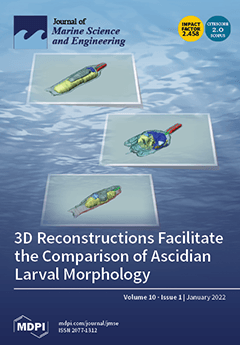Neopyropia yezoensis is an economically important marine crop that can survive dehydrating conditions when nets are lifted from seawater. During this process, production of oxygen radicals and the resulting up-regulation of antioxidant enzymes mediated by the abscisic acid (ABA) signaling pathway played an
[...] Read more.
Neopyropia yezoensis is an economically important marine crop that can survive dehydrating conditions when nets are lifted from seawater. During this process, production of oxygen radicals and the resulting up-regulation of antioxidant enzymes mediated by the abscisic acid (ABA) signaling pathway played an important role. However, there were no reports about the significance regarding the protection of seaweed throughout the entire production season. Especially, in new aquatic farms in Shandong Province that were formed when traditional
N. yezoensis cultivation moved north. Here, we determined the levels of ABA, hydrogen peroxide (H
2O
2), soluble protein, chlorophyll, and cell wall polysaccharides in samples collected at different harvest periods from Jimo aquatic farm, Shandong Province. The activities and expression of NADPH oxidase (NOX) and antioxidant enzymes in the corresponding samples were also determined. Combined with the monitoring data of sea surface temperature and solar light intensity, we proposed that the cultivation of
N. yezoensis in Shandong Province was not affected by high-temperature stress. However, photoinhibition in
N. yezoensis usually occurs at noon, especially in March. Both the activities and the expression of NOX and antioxidant enzymes were up-regulated continuously. It is reasonable to speculate that the reactive oxygen species (ROS) produced by NOX induced the up-regulation of antioxidant enzymes through the ABA signaling pathway. Although antioxidant enzymes play a pivotal role during the cultivation of
N. yezoensis, the production of ROS also caused a shift in gene expression, accumulation of secondary metabolites, and even decreased the chlorophyll pool size, which eventually led to a decrease in algae assimilation. Accordingly, we suggest that the dehydration of
N. yezoensis nets should be adopted when necessary and the extent of dehydration should be paid special consideration to avoid an excessive cellular response caused by ROS.
Full article





